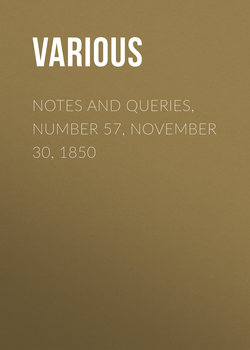Читать книгу Notes and Queries, Number 57, November 30, 1850 - Various - Страница 1
NOTES
PORTRAIT OF CARDINAL BEATON
ОглавлениеA portrait of this eminent Man was engraved by Pennant, from a picture at Holyrood House, in Part II. of his Tour in Scotland, p. 243. 4to. Lond. 1776. Lodge has an engraving from the same portrait in his collection of Illustrious Personages. This is a strange circumstance; because, when Pinkerton was about to include this portrait in his collection, Pennant wrote to him, on 30th April, 1796, as follows:
"Give me leave to say, that I suspect the authenticity of my Cardinal Beaton. I fear it is Cardinal Falconer or Falconieri. I think there is a genuine one somewhere in Scotland. It will be worth your while to inquire if there be one, and engrave it, and add my suspicions, which induce you do it."—Pinkerton's Correspondence, vol. i. p. 402. 8vo. Lond. 1830.
Pinkerton made inquiry, and on Dec. 1st, 1797, writes to the Earl of Buchan:
"Mr. Pennant informs me the Cardinal Beaton is false. It is, indeed, too modern. A real Beaton is said to exist in Fife."—Pinkerton's Correspondence, vol. ii. p. 17.
Lord Buchan writes to him that Mr. Beaton, of Balfour, believes himself to have a genuine portrait of the Cardinal, and offers it for engraving. The authenticity of this portrait, however, appears not to have been established, and it was not engraved. Another was found at Yester, and was at first concluded to be a genuine original: but Lady Ancram soon discovered that it possessed no marks of originality, but might be a good copy: it was, however, certainly not one of the six cardinals purchased by the third Earl of Lothian. Finally, it was rejected altogether. A copy of a portrait from the Vatican was also rejected as undoubtedly spurious. It appears, therefore, that Pinkerton, in this case at least, exercised caution in the selection of his subject for engraving, so far as concerned authenticity. His criticism, that the Holyrood House portrait is "too modern," will be agreed in by all who will take the trouble to compare the portrait in Lodge with undoubted portraits of the time: the style is too modern by a hundred years. But the portrait is of a man upwards of sixty years old: Beaton was murdered in 1546, in the fiftieth year of his age. The portrait is of a dark haired man without beard.
I now come to a portrait of Beaton which there appears reason to think is genuine, and I beg the favour of your correspondents to give me any information in their power regarding it. This portrait is in the Roman Catholic College at Blairs, near Aberdeen. It was in the Scotch College at Rome down to the period of the French occupation of that city in 1798, and formed part of the plunder from that college. It was subsequently discovered in a sale-room by the late Abbé Macpherson, rector of the same college, who purchased it and sent it to Blairs, where it has been for, now, a good many years. That it is a portrait of Beaton's time is certain; but the artist is unknown, and the picture has sustained damage. It is attributed, by a competent judge, who has himself painted two careful copies of it, to Titian, not only from its general style and handling, but from certain peculiarities of canvas, &c., on which latter circumstances, however, he does not lay much stress, taking them only as adminicles in proof. The portrait is a half-length, about 2 ft. 6 in. by 2 ft.: it is that of a fresh-coloured, intellectual man, of forty-five or upwards; hazel eyes; hair slightly reddish, or auburn, just becoming tinged with grey; a thin small beard; costume similar to that of Holbein's Cardinal Wolsey, in the hall of Christchurch, Oxford. It bears this inscription, painted at the bottom of the portrait, and over the original finished painting, and therefore of a subsequent date:
"David Betonius, S.R.E., Card. Archiep. S. Andreæ in Scotia, ab Hostibus Fidei Barbare Trucidatus."
Beaton was elected to the Cardinalate in Dec. 1538; did he visit Rome after that? He was at all events in Paris. The Scotch College at Rome was a natural habitat for a portrait of a Scottish churchman so famous as Cardinal Beaton, and it would be strange indeed if they had not one of him where they affected a collecion of portraits of British prelates. I propose to have this portrait engraved, if its probable authenticity cannot be shaken. Did Pinkerton engrave any portrait of Beaton? There is none in my copies of his Iconographia Scotica, 1797, and his Scottish Gallery, 1799. These contain several duplicates; but it is rare to meet with copies that can be warranted perfect. If the portrait be published, it will probably be accompanied by a short memoir, correcting from authentic documents some of the statements of his biographers: any information either as to the portrait or his life will be thankfully acknowledged. One or two letters from Lord Buchan, on the subject of Scottish Portraits, appeared in the Gentleman's Magazine, vol. lxv., but not relating to this particular one.
SCOTUS.
